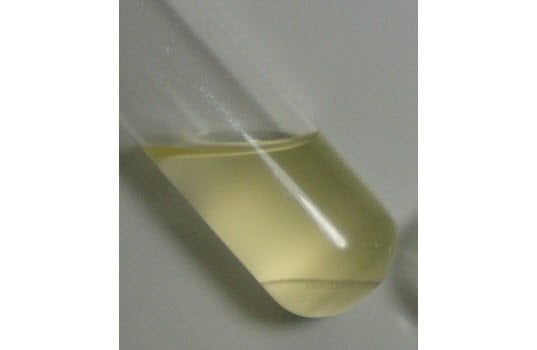Matt Moore, Technical Director, and Scott Crawford-CLS, VP Technical Sales, Primrose Oil Company
If your engine has spark plugs it is probably designed to use gasoline–right? Well, according to the American Society of Testing & Materials that fuel is not gasoline anymore. The ASTM Designation D4814-09b is described as “Standard Specification for Automotive Spark-Ignition Engine Fuel.”
Gasoline is no longer gasoline when ethanol is added. It has become e-gas. Pure gasoline and water do not mix. At least not until ethanol is added.
Many states have mandated the blanket use of ethanol on top of the traditional use of ethanol as an oxygenator in the reformulated gasolines for EPA non-attainment areas.
As discussed in Section X8 of the ASTM D4814-09b; water tolerance is of great concern.
Water in gasoline is a very real and genuine threat. But just how does water enter the gasoline? There are many ways in which water can enter the tank. It can enter from rain water through a tank opening that was left open by accident, but the really scary way water can enter the system is thorough the Earth’s normal process of condensation.
Ethanol is hygroscopic in nature, meaning that ethanol is a highly effective scavenger of water to the point that moisture can be pulled into a tank from air. Water tolerance decreases as the temperature of the ethanol/gasoline blend decreases. Therefore, when the temperature dips (more likely in spring and fall) the saturation point is easier to hit resulting in the phenomena called phase separation.
This phenomenon can actually be seen with the naked eye. A fuel sample in a clear vessel can be induced to “phase separate” and appears “like water” in the bottom.
So, maybe you are wondering what a little bit of water that has phase-separated and fallen to the bottom of the gas tank can hurt? Well, in ethanol-blended gasoline the water doesn’t just fall to the bottom by itself. The water will, in fact, begin to remove the ethanol along with the water. The layer or phase on the bottom of the gasoline tank encompasses ethanol, or some of the “octane” and water.
I bet you are wondering what problems this can lead to? Take a guess. If we are talking about gasoline in a four stroke engine, water and ethanol might combust in the engine. The air-to-fuel ratio in this combustion mixture is higher than ideal causing a lean state in the fuel. This lean mixture can damage the engine since it will tend to combust at a higher temperature leading to knocking and physical damage to the piston(s) and valves.
Now I bet you are wondering, “What kind of problems can occur in a two stroke engine?” Well, the water/ethanol phase has chemical effects where it will compete, hand-in-hand, with the blended oil in the gasoline for bonding to metal in the engine. This, of course, will in turn cause a state of non-lubrication of the metal parts, thus leading to wear, rust, metal shavings and eventually to engine failure if a state of non-lubrication is sustained. These are not the only problems that can occur because of phase separation.
The remaining gasoline phase has now lost some of its octane. This can lead to problems including knocking, loss of power and loss of efficiency and economy. Even though some newer vehicles contain knock sensors, they too will still experience the loss of power and loss of efficiency.
Phase separation can occur in bulk storage tanks or an onboard fuel tank. The problems created are the same. The water/ethanol phase is unusable and corrosive. The remaining gasoline phase, as noted above, is no longer the same octane rating. This changes the posted and regulated pump information subjecting the retailer to potential shut-down by state inspectors.
What are you to do after phase separation has occurred? Maybe your first thought is to dispose of this material. However, disposal can be rather costly and is considered hazardous waste.
Volumes have been written and appear all over the internet that disposal is exactly what you are supposed to do. You are up the proverbial creek without a paddle; that there is no viable solution to phase separation; that you just have to take your lumps and eat the expense.
Fortunately there are products that exist, that can prevent and/or reverse phase separation. Prevention additives will help to keep your fuel within specification by keeping water dispersed so it can pass through the combustion process exiting as vapor and thereby avoiding or at least minimizing a potentially expensive and time consuming situation.
If the fuel has phase separated it can be reversed, and safely used in the normal combustion process.
There are cases though of excessive water where the only option may be disposal. Research indicates that if the water level exceeds 5,000 PPM disposal would be the best solution.
Consult your fuel additive supplier to determine if they have access to the products that really do work. It could save you a lot of aggravation not to mention a lot of money.
Primrose Oil Company offers a full gamut of gasoline and diesel fuel additives, including solutions for internal diesel injector deposits (IDID) and Phaser 3000 for the prevention and reversal of Phase Separation. Products are offered in both bulk and retail packaging.
 Matt Moore ([email protected]) is the Technical Director at Primrose Oil Company, Inc. He researched and developed Phaser 3000 for the prevention and reversal of Phase Separation and has experience in both diesel and gasoline fuel additives. He has a Bachelor of Science degree in Toxicology.
Matt Moore ([email protected]) is the Technical Director at Primrose Oil Company, Inc. He researched and developed Phaser 3000 for the prevention and reversal of Phase Separation and has experience in both diesel and gasoline fuel additives. He has a Bachelor of Science degree in Toxicology.
 Scott Crawford ([email protected]) is Vice President Technical Sales at Primrose Oil Company. He has 34 years experience in the fuel treatment market. He has a Bachelor of Business Administration degree and is a Certified Lubrication Specialist and a 17 year member of the Society of Tribologists & Lubrication Engineers.
Scott Crawford ([email protected]) is Vice President Technical Sales at Primrose Oil Company. He has 34 years experience in the fuel treatment market. He has a Bachelor of Business Administration degree and is a Certified Lubrication Specialist and a 17 year member of the Society of Tribologists & Lubrication Engineers.
Note: The opinions expressed here are those of the author(s) and not necessarily those of FMN.








